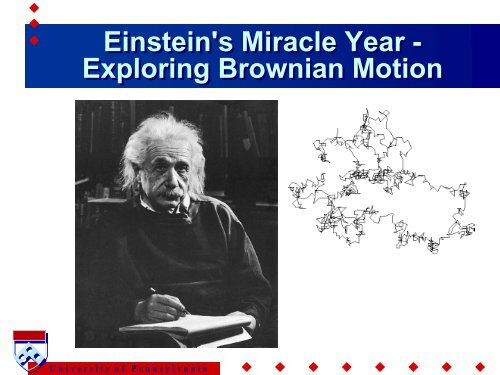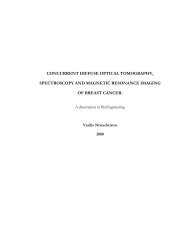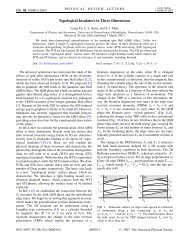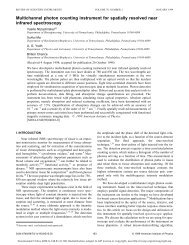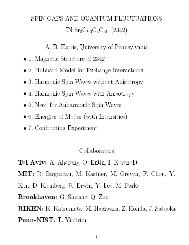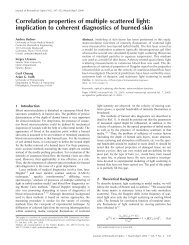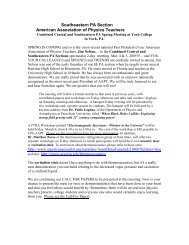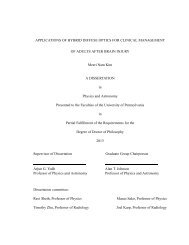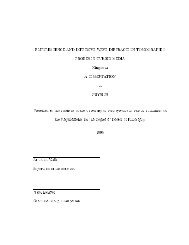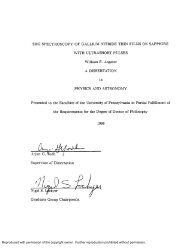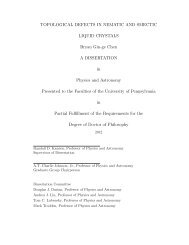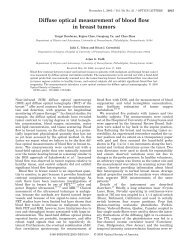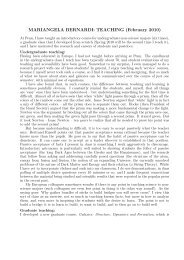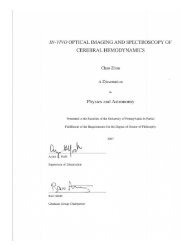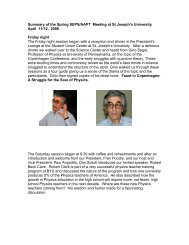Einstein's Miracle Year - Exploring Brownian Motion Einstein's ...
Einstein's Miracle Year - Exploring Brownian Motion Einstein's ...
Einstein's Miracle Year - Exploring Brownian Motion Einstein's ...
Create successful ePaper yourself
Turn your PDF publications into a flip-book with our unique Google optimized e-Paper software.
<strong>Einstein's</strong> <strong>Miracle</strong> <strong>Year</strong> -<br />
<strong>Exploring</strong> <strong>Brownian</strong> <strong>Motion</strong><br />
U n i v e r s i t y o f P e n n s y l v a n i a
Einstein’s <strong>Miracle</strong> <strong>Year</strong> (1905)<br />
U n i v e r s i t y o f P e n n s y l v a n i a
What did he write about in 1905?<br />
<strong>Brownian</strong> <strong>Motion</strong><br />
– Evidence for existence of Atoms/Molecules<br />
– Estimation of the size of atoms/molecules<br />
– Estimation of Avogodro’s number<br />
– Evidence for microscopic ‘fluctuations’ of the<br />
properties of matter<br />
– Random walks in nature<br />
U n i v e r s i t y o f P e n n s y l v a n i a
What did he write about in 1905?<br />
• Theory of Special Relativity<br />
– New notions about the measurement<br />
of time and length intervals<br />
– Energy associated with mass of an<br />
object, E = mc2 U n i v e r s i t y o f P e n n s y l v a n i a<br />
"Earth magic landscapes"<br />
http://www.flytrap.it/public/faiweb/
What did he write about in 1905?<br />
• Photoelectric Effect<br />
– Birth of quantum mechanics<br />
– Defined energy carried by photons<br />
(the smallest “particles” of light)<br />
U n i v e r s i t y o f P e n n s y l v a n i a<br />
INCOMING<br />
PHOTONS<br />
OUTGOING<br />
ELECTRONS
<strong>Brownian</strong> <strong>Motion</strong>: What is it?<br />
Who was Robert Brown?<br />
U n i v e r s i t y o f P e n n s y l v a n i a<br />
Why do the particles move?
<strong>Brownian</strong> <strong>Motion</strong> all Around Us<br />
U n i v e r s i t y o f P e n n s y l v a n i a
<strong>Brownian</strong> <strong>Motion</strong>: Size Dependence<br />
U n i v e r s i t y o f P e n n s y l v a n i a<br />
2 µm and 10 µm<br />
diameter<br />
beads in water
U n i v e r s i t y o f P e n n s y l v a n i a<br />
Particle Tracking<br />
trajectory<br />
y (µm)<br />
profile<br />
centroid<br />
x (µm)
<strong>Brownian</strong> <strong>Motion</strong>: Viscosity Dependence<br />
2 µm beads in water 2 µm beads in 50% glycerol<br />
U n i v e r s i t y o f P e n n s y l v a n i a
John Dalton<br />
Physics around 1900<br />
What are ‘things’ made of?<br />
If you keep dividing a drop<br />
of water into two parts, then<br />
what do you end up with?<br />
Atomic Hypothesis: Matter is<br />
composed of atoms and molecules.<br />
• Useful for understanding ‘chemical combination’,<br />
the behavior of gases, and other phenomena.<br />
• BUT no direct evidence for atoms.<br />
Cornell Center for Materials Research<br />
© Cornell University<br />
http://www.news.cornell.edu/<br />
U n i v e r s i t y o f P e n n s y l v a n i a
Physics around 1900<br />
Thermodynamics from Statistical Behavior of Many Atoms<br />
• Fluctuations<br />
From: A Review of the Universe http://universe-review.ca<br />
U n i v e r s i t y o f P e n n s y l v a n i a<br />
Carnot<br />
Bolztmann
Einstein’s Picture of Water<br />
U n i v e r s i t y o f P e n n s y l v a n i a<br />
• <strong>Brownian</strong> Particles area about<br />
1 micron in diameter (1/1000th of<br />
a millimeter)<br />
• Water Molecules are about 10,000<br />
times smaller in diameter!
Einstein’s Picture of Water<br />
U n i v e r s i t y o f P e n n s y l v a n i a
Analysis of Trajectories<br />
U n i v e r s i t y o f P e n n s y l v a n i a
Analysis of Trajectories: Raw Images<br />
t = 0 sec. t = 2 sec. t = 4 sec.<br />
t = 6 sec. t = 8 sec. t = 10 sec.<br />
U n i v e r s i t y o f P e n n s y l v a n i a
Analysis of Trajectories: Displacements<br />
t = 0 s.<br />
t = 4 s.<br />
∆y<br />
∆<br />
∆x<br />
∆r<br />
2<br />
r = ∆x<br />
+ ∆<br />
U n i v e r s i t y o f P e n n s y l v a n i a<br />
y<br />
2<br />
t = 6 s.<br />
∆y<br />
∆x<br />
∆r
Analysis of Trajectories: Table<br />
t (sec)<br />
0<br />
2<br />
4<br />
6<br />
8<br />
10<br />
∆x<br />
(µm)<br />
∆y<br />
(µm)<br />
U n i v e r s i t y o f P e n n s y l v a n i a<br />
∆x 2<br />
(µm 2 )<br />
∆y 2<br />
(µm 2 )<br />
∆x 2 +∆y 2<br />
(µm 2 )<br />
0 0 0 0 0 0<br />
- 1.2<br />
- 1.5<br />
0.7<br />
1.7<br />
(∆x 2 +∆y 2 ) 1/2<br />
(µm)<br />
1.44 0.49 1.93 1.39<br />
2.25 2.89 5.14 2.27
Delta x^2 + Delta y^2 (microns squared)<br />
10<br />
9<br />
8<br />
7<br />
6<br />
5<br />
4<br />
3<br />
2<br />
1<br />
0<br />
Analysis of Trajectories: Plots<br />
Mean Square Displacement vs. time<br />
0 2 4 6 8 10<br />
time (sec)<br />
U n i v e r s i t y o f P e n n s y l v a n i a<br />
Particle Trajectory<br />
y (micron)<br />
6<br />
4<br />
2<br />
x (micron)<br />
0<br />
-6 -4 -2 0 2 4 6<br />
-2<br />
-4<br />
-6
Analysis of Student’s Results<br />
U n i v e r s i t y o f P e n n s y l v a n i a
Computer Analysis of Tracking<br />
U n i v e r s i t y o f P e n n s y l v a n i a<br />
∆r ∝<br />
2<br />
t
2 2<br />
∆ x = ∆y<br />
= 2Dt<br />
(1D)<br />
2<br />
∆r<br />
= 4Dt<br />
2<br />
∆ r = 6Dt<br />
U n i v e r s i t y o f P e n n s y l v a n i a<br />
1D vs. 2D<br />
(2D)<br />
(3D)
What did Einstein Tell Us About <strong>Brownian</strong> <strong>Motion</strong>?<br />
• Microscopic picture of water.<br />
– Composed of tiny particles (atoms/molecules)<br />
– Molecules have an average kinetic energy (KE)<br />
related to the water temperature (1/2 m v2 ~ kT)<br />
– Kinetic energy fluctuates! (∆KE ~ kT)<br />
• Collisional fluctuations of molecules<br />
“hitting” large sphere cause the <strong>Brownian</strong><br />
particle to move.<br />
U n i v e r s i t y o f P e n n s y l v a n i a
What did Einstein Tell Us About <strong>Brownian</strong> <strong>Motion</strong>?<br />
• Collisions occur in random directions and<br />
at random times. <strong>Brownian</strong> particle<br />
‘moves’ like a random walker<br />
Particle Diffusion<br />
Coefficient<br />
∆r 2 ~ D t ; (∆r 2 ) 1/2 ~ t 1/2<br />
U n i v e r s i t y o f P e n n s y l v a n i a<br />
D = kT/6πηa<br />
Constant<br />
(N Avogodro k = R)<br />
Temperature Viscosity Particle Radius
What did Einstein Tell Us About <strong>Brownian</strong> <strong>Motion</strong>?<br />
• Results broadly applicable<br />
(e.g. small molecules dissolved in water)<br />
U n i v e r s i t y o f P e n n s y l v a n i a
U n i v e r s i t y o f P e n n s y l v a n i a<br />
Jean Perrin
Key Elements of Random Walks<br />
Step Size = l*<br />
(Distance ‘walker’ travels before its direction is changed)<br />
#Steps = N<br />
(Total number of steps taken by ‘walker’)<br />
Mean-square-Displacement = ∆r 2<br />
(Square of the ‘Net’ Distance walker moves)<br />
∆r2 ~ N(l* l*) 2 ; (∆r2 ) 1/2 ~ N 1/2 (l* l*)<br />
U n i v e r s i t y o f P e n n s y l v a n i a
Other Examples of Random Walks<br />
Polymers<br />
Very, very long chain molecules<br />
Polyethylene: …. -CH 2 –CH 2 –CH 2 –CH 2 - …. or [CH 2] N<br />
N repeats of fundamental chemical unit.<br />
U n i v e r s i t y o f P e n n s y l v a n i a
Other Examples of Random Walks (Polymers)<br />
What do polymer chains really look like?<br />
Not straight!<br />
Polymer chains are built from ‘steps’ or<br />
‘chainlinks’ of molecules.<br />
Direction of neighboring ‘chainlinks chainlinks’<br />
changes randomly.<br />
U n i v e r s i t y o f P e n n s y l v a n i a
Other Examples of Random Walks (Polymers)<br />
Conformation (i.e. the shape) of a Polymer<br />
Chain traces out a random walk like path!<br />
Stepsize = ‘chainlink’ length = l*<br />
#Steps = Total length/stepsize = L/l*<br />
Typical size ~ (L/l*) 1/2 l*<br />
U n i v e r s i t y o f P e n n s y l v a n i a<br />
Chester Liu<br />
Universal Molecular Simulator<br />
http://rati.pse.umass.edu/~cht/research/usim/
Other Examples of Random Walks (Light)<br />
U n i v e r s i t y o f P e n n s y l v a n i a
Other Examples of Random Walks (Light)<br />
Light diffuses through lot’s lot s of media!<br />
When light is scattered its direction changes.<br />
Stepsize = (speed of light) x (time between scattering events)<br />
#Steps = (Total time) / (time between scattering events)<br />
Distance traveled ~ (Total time) 1/2<br />
U n i v e r s i t y o f P e n n s y l v a n i a
Other Examples of Random Walks (Light)<br />
Current Applications: Imaging in Human Tissue<br />
U n i v e r s i t y o f P e n n s y l v a n i a<br />
20 th Century Fox: Minority Report
U n i v e r s i t y o f P e n n s y l v a n i a<br />
More on Einstein<br />
Light Absorption and Emission<br />
From: R. Keenan, Ph.D.<br />
Providence High School,<br />
Charlotte, NC<br />
• Stimulated and Spontaneous Emission –<br />
Basis for Modern Day Lasers<br />
From: University of Aberdeen<br />
http://www.eng.abdn.ac.uk/comms/candi/facilities.html
U n i v e r s i t y o f P e n n s y l v a n i a<br />
More on Einstein<br />
Theory of General Relativity<br />
(A fundamentally better description of gravity)<br />
From: ZARM - Center of Applied Space<br />
Technology and Microgravity<br />
http://www.zarm.uni-bremen.de<br />
From: NASA http://www.nasa.gov
U n i v e r s i t y o f P e n n s y l v a n i a<br />
More on Einstein<br />
Critic of Quantum Mechanics<br />
Taken from: http://chaos.swarthmore.edu
U n i v e r s i t y o f P e n n s y l v a n i a<br />
More on Einstein<br />
Influence on World Affairs<br />
• Urged development of Atomic<br />
Bomb during WW II<br />
• Later became a pacifist
U n i v e r s i t y o f P e n n s y l v a n i a<br />
Nobel Prize<br />
Photoelectric Effect


